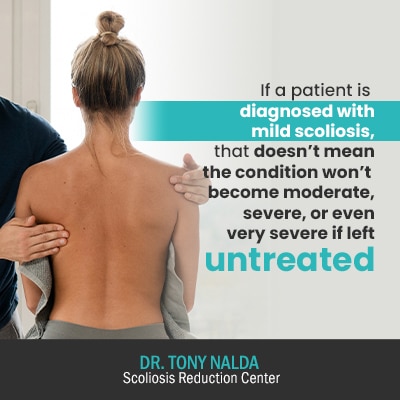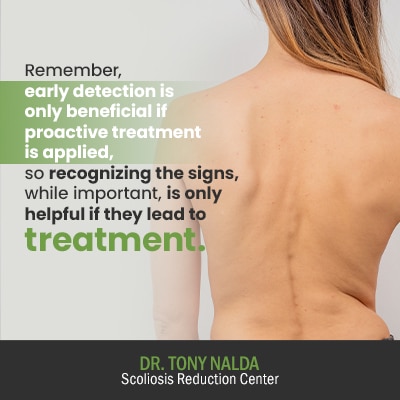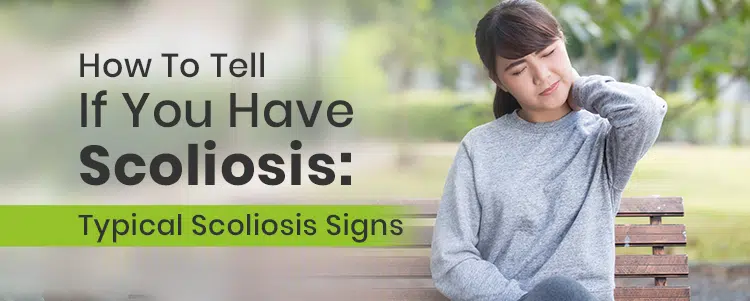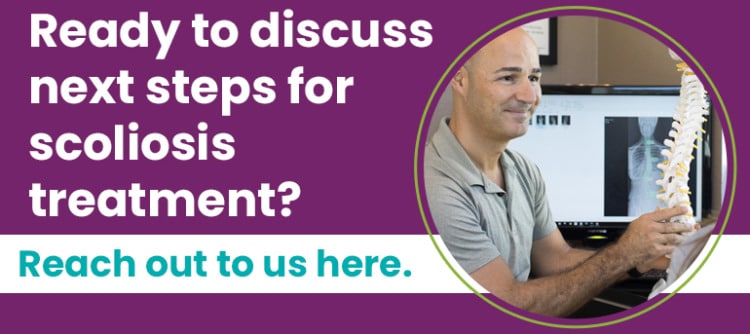Scoliosis isn’t always easy to detect. At one time, school nurses provided scoliosis screening, but that has since changed, and the onus falls on parents/caregivers to spot the typical scoliosis signs in children. I say parents/caregivers because the most prevalent condition is adolescent idiopathic scoliosis (AIS). While each case is unique, telltale signs of scoliosis include uneven shoulders and hips.
The earliest signs of scoliosis are changes to the body’s symmetry. Knowing the signs to look for is important because not all are overt; some are subtle and only recognizable to trained experts or those educated in precisely what to look for. Recognizing the signs can help with early detection.
Before exploring the typical scoliosis signs, let’s first discuss what is happening inside the body of a person with scoliosis to have a clearer understanding of what the signs are indicating.
What a Scoliosis Diagnosis Means
First, the only way to definitively know if you have scoliosis is to be examined and assessed by a medical professional; that being said, there are signs a person can look for that indicate the need for further testing.
If a person is diagnosed with scoliosis, their spine has an unnatural sideways spinal curve, with rotation and a minimum Cobb angle measurement of 10 degrees.
A healthy spine has natural curvatures that make it appear straight when viewed from the front or back, and when viewed from the sides, the spine has a soft ‘S’ shape.
The spine’s natural and healthy curvatures make it stronger, more flexible and allow it to evenly distribute/absorb mechanical stress, so no one section of the spine is exposed to uneven weight/wear.
The rotation element makes scoliosis a 3-dimensional condition, meaning the spine doesn’t just bend unnaturally to the side but also twists from back to front, front to back.
The 3-dimensional nature of scoliosis is an important characteristic because treatment will only be effective if it addresses the condition as such; in fact, being addressed as a 2-dimensional condition is one of the major shortfalls of traditional scoliosis treatment, which we’ll return to later.
Cobb angle is commonly referred to as the orthopedic gold standard in assessing scoliosis.
The Cobb angle is a measurement obtained via X-ray that involves drawing intersecting lines from the tops and bottoms of the scoliotic curve’s most-tilted vertebrae. The resulting angle is measured in degrees. It indicates how far out of alignment the spine is and places conditions on a severity scale of mild, moderate, severe, or very severe.
- Mild scoliosis: Cobb angle measurement of between 10 and 25 degrees
- Moderate scoliosis: Cobb angle measurement of between 25 and 40 degrees
- Severe scoliosis: Cobb angle measurement of 40+ degrees
- Very-severe scoliosis: Cobb angle measurement of 80+ degrees
After defining the parameters that must be met to reach a scoliosis diagnosis, what do they mean for the spine and the rest of the body?
How To Diagnose Scoliosis
Diagnosing scoliosis typically begins with either personal observation or during routine physical examinations when someone notices signs indicative of a spinal condition. Early recognition of symptoms such as posture changes, asymmetry in the shoulders or hips, or clothes fitting differently can prompt further investigation. The formal diagnostic process involves a medical history review and a physical examination by a healthcare professional, who may then perform specific tests, such as the Adam’s forward bend test, to visually assess spinal curvature and symmetry.
If these initial evaluations suggest the presence of scoliosis, an X-ray is ordered to confirm the diagnosis. The X-ray is crucial as it provides detailed images of the spine, allowing for the measurement of the Cobb angle—the primary metric used to determine the presence and severity of scoliosis. This angle helps classify the condition as mild, moderate, severe, or very severe, based on the degree of spinal curvature, and guides the subsequent treatment planning.
The diagnostic process for scoliosis varies slightly between adolescents and adults due to differences in symptoms and the progression of the condition. Adolescent idiopathic scoliosis (AIS), the most common form, often presents without pain, making early detection challenging yet critical for effective treatment. For adults, pain is a more prominent symptom, especially in cases of degenerative scoliosis where spinal degeneration leads to curvature.
Adults may also present with idiopathic scoliosis that was undiagnosed during adolescence, becoming symptomatic only when the spine has fully matured. Regardless of the patient’s age, the diagnosis follows a structured approach involving a physical exam and an X-ray to confirm the presence and extent of the curvature. Early diagnosis is essential in both groups for initiating timely treatment, aiming to manage progression and alleviate symptoms, thereby enhancing quality of life.
Scoliosis Screening
While scoliosis screening used to be offered in schools, conducted by the school nurse when it comes to children, the onus is now on parents to seek out scoliosis screening options, and knowing the condition’s early telltale signs can help with early detection.
When it comes to scoliosis screening, this would involve a physical exam, during which time I observe the patient’s posture and gait; I can tell a lot about a patient’s spine by the way they walk.
I also take the patient’s medical and family history. While scoliosis is considered more familial than genetic, the likelihood of developing scoliosis does increase if another family member has it.
Then I’ll perform an Adam’s forward bend test, which is a safe, noninvasive screening exam, and while it’s not a diagnostic tool on its own, it does indicate whether or not further testing is warranted.
The patient stands upright with their arms at their sides, and then they bend forward as if going to touch their toes at a 90-degree angle; in this position, the spine and any related postural deviation are highly visible.
Next, I use what’s known as a Scoliometer. This looks almost like a ruler with a bubble inside. I run it along the spine to gauge the angle of trunk rotation (ATR).
If the bubble in the Scoliometer aligns with 7 degrees, this equates to around a 20-degree measurement on an X-ray. When the Adam’s test is combined with a Scoliometer, it’s even more effective at screening for condition indicators.
So what are the condition’s early telltale signs, and how does the diagnostic process differ between children and adults?
How Scoliosis Affects the Body
To understand how scoliosis affects the body, let’s first talk about the spine and its functions on the body.
The human spine is the body’s central support structure; it allows us to remain upright, practice good posture, absorb mechanical stress, stand, sit, walk, twist, bend, and transfer the torso’s weight to the lower body.
The spine also connects parts of the musculoskeletal system. It works in tandem with the brain to form the body’s central nervous system: facilitating communication between the brain and the rest of the body.
As part of the CNS, the spine is involved in the function of virtually every working system within the body, so you can see how a spinal condition like scoliosis can cause a myriad of effects felt throughout the body, and not just in the back.
As scoliosis involves an unnatural spinal curve, this introduces a lot of uneven forces to the body. As a progressive condition, scoliosis has it in its nature to worsen over time, especially if severe or if not treated proactively.
It’s also important to understand that there aren’t just different severity levels of scoliosis but many other variables that shape a person’s life experience with the condition: patient age, curvature location, causation, and severity.
In other words, no two cases are the same, with each giving different signs and developing its unique symptoms.
So how does scoliosis affect the body? Firstly, the loss of the spine’s healthy curves can disrupt messages passing between the brain and the rest of the body, affecting multiple areas of function such as movement, digestion, menstruation, balance and coordination, breathing, and more.
Scoliosis also shifts the body’s center of gravity, as the spine is unnaturally curved to the side. Since it’s normally a healthy spine running straight through the center of the torso that marks a body’s center of gravity, this shift can cause balance, coordination, proprioception, and gait issues.
As a scoliotic curve increases in size, it can cause postural changes that change the body’s overall symmetry, which can also cause clothing to become ill-fitting.
Scoliosis can also cause back and radicular pain (depending on the degree of nerve involvement) but is far more common in adult scoliosis rather than in its most-prevalent form of adolescent idiopathic scoliosis.
Scoliosis can also cause muscle pain; since it’s not just the spine itself that’s responsible for maintaining its healthy curves and alignment but also its surrounding muscles that provide it with crucial support/stabilization.
So now that we have talked about how scoliosis affects the body in general terms, let’s focus on the importance of early detection and the most typical scoliosis signs.
Scoliosis and Early Detection
As mentioned, scoliosis is progressive, meaning it’s virtually guaranteed to get worse at some point. Given its progressive nature, it’s incurable; however, scoliosis is highly treatable. Just because we don’t always know what causes it, it doesn’t mean we don’t know how to manage it effectively.
Also, as mentioned, scoliosis ranges from mild to moderate and severe to very severe. Where a patient’s scoliosis is at the time of diagnosis is not indicative of where it will stay.
Scoliosis is not a static condition, and as such, one of the main goals of treatment is to prevent further progression.

If a patient is diagnosed with mild scoliosis, that doesn’t mean the condition won’t become moderate, severe, or even very severe if left untreated.
In addition to different severity levels, a person can develop different types of scoliosis based on causation.
One of the most interesting things about scoliosis is that 80 percent of known diagnosed cases are classified as idiopathic, meaning not associated with a single clear causative source. The remaining 20 percent have known causes and are classified as neuromuscular, congenital, degenerative, or traumatic scoliosis.
As adolescent idiopathic scoliosis (AIS), diagnosed between the ages of 10 and 18, is the most prevalent type of scoliosis, we’ll focus on this form for the bulk of the article.
While we don’t know what causes idiopathic scoliosis, we know what triggers its progression: growth.
Adolescents who are entering into, or are in, the stage of puberty when diagnosed are at risk for rapid-phase progression because of the rapid and unpredictable growth spurts that characterize puberty.
So in children and adolescents who have not yet reached skeletal maturity, I know that monitoring and adjusting treatment plans to stay ahead of a condition’s progressive line is key to success.
While there are no treatment guarantees, early detection increases the chances of treatment success, particularly when it comes to AIS because progression tends to be faster in young patients who have not yet reached skeletal maturity.
Catching a condition while mild is an opportunity to keep it that way; it’s far simpler to treat a scoliotic curve while still mild because spinal rigidity increases with progression, making the spine harder to adjust and less responsive to treatment.
In addition, once a scoliotic curve has been developing/progressing over time, the body has had time to adjust to its presence, and the larger the curve, the more intense effective treatment will need to be.
Here at the Scoliosis Reduction Center®, I believe in proactively starting treatment as close to the time of diagnosis as possible so valuable treatment time isn’t wasted, and increasing condition severity can be prevented.
Now that we’ve touched on the merits of early detection, let’s talk about how it’s achieved: knowing the typical scoliosis signs to expect.
Typical Scoliosis Signs
Again, while there are no treatment guarantees, the best time to treat scoliosis with a chiropractic-centered treatment approach, like the one I offer, is while conditions are still mild.
When scoliosis is detected and treated early, a conservative approach has the potential to reduce curvatures on a structural level for corrective results and prevent further progression.
In addition, early detection and treatment can help avoid the need for more invasive forms of treatment in the future, like spinal fusion. Still, there are several reasons why it’s not always easy to spot scoliosis in mild conditions.
Initially, mild scoliosis doesn’t cause functional deficits, and even the postural changes it causes can be subtle at this stage.
While an expert trained in the subtleties of mild scoliosis signs would be able to spot the indicators, an average parent or adolescent could easily miss them.
Perhaps the biggest reason scoliosis is hard to detect in adolescents is because the condition is not known to be overly painful. While no one wants to experience it, pain does alert us that something inside the body is amiss.
Scoliosis isn’t known as painful for children and adolescents because while growth is still occurring, the condition is not compressive; the lengthening motion of the growing spine counteracts the compressive force of the curvature.
While scoliosis isn’t commonly associated with back pain in adolescents, approximately 20 percent experience muscle pain. Scoliosis is also closely associated with headaches, disrupting the flow of cerebrospinal fluid (CSF) in the spinal canal and lowering its levels in the brain.
So you can see the challenges of diagnosing mild scoliosis in adolescents; however, knowing the typical scoliosis signs to look for is the first step to early detection and proactive treatment.
Signs of Mild Scoliosis
Again, while every case is different and will produce its unique signs and symptoms, typical mild scoliosis signs to watch for include:
- Ill-fitting clothing
- Issues with balance/coordination
- Changes to gait
- Head uncentered over the torso
- An arm hanging lower than the other
- Ribs protruding more on one side than the other
- A leg that appears longer than the other
- One hip that sits higher than the other
- An asymmetrical waistline
- One shoulder blade protruding more than the other
- Asymmetrical space between the arms and torso
In general, noticeable changes to balance, coordination, gait, and any indication that the body’s natural symmetry has been disrupted could be signs of mild scoliosis. Still, again, at this level, these changes are subtle.
Signs of Moderate Scoliosis
Due to the subtlety of many of the mild scoliosis signs, the reality is that most scoliosis patients are diagnosed while in the moderate stage; at this stage, patients have progressed beyond mild levels/symptoms into the next stage, when the signs become more noticeable.
The reality is that by the time a condition has progressed from mild to moderate, it will continue to do so unless proactive treatment is applied.
In general, the signs of mild scoliosis are simply more pronounced once it progresses to moderate, and in addition, signs of moderate scoliosis include:
- Being able to see the spine’s rotation/abnormal curve with the naked eye
- Rib arches are common
- Shoulder blades protrude out from the body more noticeably
- Shoulders become overtly asymmetrical
- Posture suffers as the body becomes less symmetrical
The postural changes that occur in moderate scoliosis are more overt and easy to spot. These changes, particularly those affecting the ribs and shoulders/shoulder blades, are also far more noticeable in a forward-bend position.
The Adam’s forward bend test is one of the best ways to screen for signs of scoliosis and involves a patient standing up and bending forward so their arms are dangling at the sides and they are at a 90-degree angle.
The spine is more prominent in this position, so any irregularities are easier to spot. For parents/caregivers of adolescents concerned about scoliosis, asking them to bend forward at the waist and carefully examine their spine can help reveal indicators for the condition and the need for further testing and assessment by a professional.

Remember, early detection is only beneficial if proactive treatment is applied, so recognizing the signs, while important, is only helpful if they lead to treatment.
Signs of Severe Scoliosis
Once scoliosis becomes severe, it has progressed beyond its mild and moderate levels, and patients, at this stage, are more likely to experience overt symptoms like functional deficits, pain, and postural changes.
For those on the traditional path of scoliosis treatment, it’s in the severe stage that patients are commonly funneled towards spinal fusion surgery, an invasive form of treatment that carries some serious potential risks and side effects.
For those living with severe scoliosis, the risk of complications is greater: digestive issues, sleep problems, headaches/migraines, respiratory issues, irregular menstrual cycles, and neck, back, and leg pain can be signs of severe scoliosis.
In addition, postural changes that indicate severe scoliosis include:
- Clothing that hangs unevenly on the body
- One arm appearing longer than the other
- One hip sitting higher than the other
- One leg appearing longer than the other
- Ribs that protrude more noticeably on one side of the body
- Shoulder blades that protrude more noticeably on one side of the body
So now that you know the typical scoliosis signs to look for at the mild, moderate, and severe levels, what are the treatment options?
Scoliosis Treatment Options
Two main scoliosis treatment approaches offer patients very different potential outcomes: conservative and traditional.
Also known as chiropractic-centered or functional, the conservative approach is what patients of the Center benefit from, and our results speak for themselves.
Because I value being proactive with treatment, I believe that the time to act with scoliosis is always now.
The traditional approach says that while a condition is mild, the correct recourse is observation to see if further progression occurs. But in the time that further progression occurs, efforts could have been made to hold the scoliosis where it was at the time of diagnosis, rather than leaving the curve to progress unimpeded.
Here at the Center, I address the condition’s true 3-dimensional nature with an integrative approach to treatment; I combine different treatment disciplines for the most specific and customized results.
By integrating in-office therapy, custom-prescribed home exercises, corrective bracing, and condition-specific chiropractic care, conditions can be impacted on multiple levels.
The conservative approach has correction as its end goal, while the traditional approach has preventing further progression as its end goal, and these are two very different things.
I work closely with patients, to first and foremost, impact their condition on a structural level because scoliosis is a structural condition. Increasing core strength is also important for providing the spine with optimal support/stabilization.
The path of treatment in the traditional approach involves observation, traditional bracing in the moderate stage, and commonly recommends spinal fusion in the severe stage, yet the approach offers nothing in terms of correction and prevention; this traditional response to scoliosis is more reactive than proactive.
The one form of treatment used in the traditional approach, bracing, is limited in its efficacy because traditional braces only address the condition as 2-dimensional, so it can’t impact it in all three dimensions.
The most important thing to understand about scoliosis is that its early signs can be subtle and that proactive treatment is always the best choice, particularly for those wanting to avoid invasive surgical procedures.
What to Do if You Think You Have Scoliosis
The most common type of scoliosis is adolescent idiopathic scoliosis, diagnosed between the ages of 10 and 18, and if an adolescent thinks they have scoliosis, they have most likely noticed some changes to their posture.
Oftentimes, the earliest signs of scoliosis in children are uneven shoulders and hips, and postural changes are caused by the condition’s uneven forces disrupting the body’s overall symmetry, and this can also cause the additional effects of changing balance, coordination, and gait.
If you have noticed some postural changes, this doesn’t guarantee you have scoliosis, but it certainly indicates the need for further testing.
The only way to definitively know whether scoliosis is present or not is to seek assessment and diagnosis from a medical professional; in most cases, scoliosis is diagnosed through taking the patient’s medical/family history, observing how a patient holds themselves (posture), walks, physical examination, and X-ray results.
An Adam’s forward bend test is also performed as the spine, and any related asymmetries, is most visible in a forward bend position, and if condition indicators are found, an X-ray is ordered to truly see what’s happening to the spine, to confirm the patient’s Cobb angle measurement, and reach an official diagnosis.
Which Scoliosis Do I Have?
When a patient receives a diagnosis of scoliosis, part of the process involves further classifying conditions based on key patient/condition variables.
Scoliosis is classified based on patient age, condition severity, curvature location, and condition type, and type is determined by causation.
Most cases of scoliosis are classified as idiopathic; in fact, approximately 80 percent of known diagnosed cases aren’t associated with a single-known cause.
And the most common type of scoliosis overall is adolescent idiopathic scoliosis, and the remaining 20 percent of known cases are associated with known causes: neuromuscular scoliosis, degenerative scoliosis, and congenital scoliosis.
The type of scoliosis a patient is diagnosed with is important because different types have different symptoms and treatment needs.
For example, neuromuscular scoliosis is caused by the presence of a larger neuromuscular condition like cerebral palsy, muscular dystrophy, or spina bifida, so treatment has to focus on the larger neuromuscular condition, which complicates the process.
Degenerative scoliosis is caused by age-related spinal degeneration so is most common in adults over the age of 50, but treatment needs are different with older adults, and the focus is more on stabilizing the spine and reducing a scoliosis back to where it was prior to becoming painful.
Cases of congenital scoliosis are rare, affecting approximately 1 in 10,000, and this type is caused by a malformed spine that develops in utero, so babies are born with the condition.
Regardless of condition severity or type, the most important thing to do once a diagnosis is given is to choose a treatment approach to commit to and start treatment immediately; with progressive conditions, the best time to start treatment is always now, and as scoliosis only gets more complex to treat the more it progresses, being proactive with treatment is key.
Conclusion
When it comes to how to tell if you have scoliosis, the best approach is empowerment through information; reading this article is a great start.
You now know that scoliosis develops across a wide severity spectrum. As such, there are different signs and symptoms characteristic of the different levels of mild, moderate, and severe scoliosis.
You also know that while there are no treatment guarantees, early detection does increase chances of treatment success; this is because treating scoliosis while mild means significant progression has not yet occurred, the spine is still flexible, and the body has not yet had time to adjust to the abnormal curve’s presence.
Once a scoliosis diagnosis is given, the most important decision is how to treat it moving forward. This means deciding between the two main scoliosis treatment approaches: conservative and traditional.
The typical scoliosis signs to watch out for are changes to overall body symmetry; uneven hips and shoulders are often the first indicators.
In adults, pain is the most obvious sign, and this is because, in patients who are no longer growing, the condition is compressive, meaning the spine and its surrounding ligaments, nerves, and muscles are exposed to the uneven force of the scoliotic curve and can become irritated.
As a parent or caregiver, if you have noticed your adolescent’s body symmetry seems off, coupled with changes to posture and gait, this is a good indicator that further testing and assessment by a scoliosis specialist is necessary.
For those wanting more information on the process of diagnosing and assessing scoliosis, don’t hesitate to reach out to us at the Scoliosis Reduction Center®.





